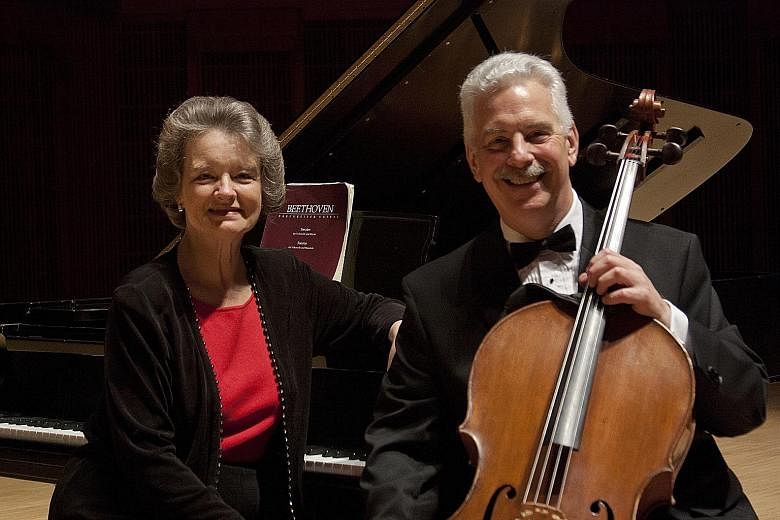REVIEW / CONCERT
MUSIC OF DARK AND LIGHT FROM THREE CONTINENTS
Fischer Duo/Yong Siew Toh Conservatory
Wednesday
The American husband-and-wife duo of cellist Norman Fischer and pianist Jeanne Fischer have been performing together for the past 43 years, so one would expect a certain closeness and familiarity within the ensemble.
And so it proved in their recital, which consisted mostly of 20th- century works and a mighty Beethoven sonata as counterweight.
Norman addressed the audience in a deep and dusky baritone voice, explaining how each work related to their lives, and that was echoed in the tone of his 1972 Sergio Peresson cello.
Opening with American composer Pierre Jalbert's Dual Velocity, the cello presented a theme based on notes spelt by the name of the duo. This was no atonal work, but an approachable one using dissonances to spice up its message.
Jeanne's spikily rhythmic piano part fitted hand-in-glove as the piece shifted gears between tempos, from lively to very fast, all through to its scintillating end.
On the opposite end of the spectrum was George Rochberg's Ricordanza (Remembrance), a slow movement that was the celebrated atonalist's tribute to the Romantic tradition.
Schumannesque lyricism and the autumnal musings of Brahms were laid on with a trowel, which was probably a bit too much of a good thing.
In between was a rarity: Zoltan Kodaly's Cello And Piano Sonata Op. 4, in two movements.
The first was a showcase of Norman's full-throated tone, issuing like a cantor during prayer time and in the lower registers.
This doleful lament in the Hungarian tradition was followed by a cheerful folk dance, where the interplay between both instruments had its comedic moments, drawing titters from segments of the audience.
Beethoven's Cello Sonata In A Major Op. 69 was the longest and best known work in the recital. The first movement was not taken too fast, rightly so when others tend to speed up. The tempo indication was Allegro Ma Non Tanto after all. This allowed the development section to sound that little bit more dramatic.
The scherzo was fitful rather than playful and, for a work that has no slow movements, the contrasts between the three movements seemed just right. The only breather lasted a minute or so, a slow song-like introduction to a joyous finale.
Still in virtuoso mode, the duo concluded their programme with Argentine tango-meister Astor Piazzolla's Le Grand Tango, composed for the late Mstislav Rostropovich.
From bordello to concert hall, this series of heady dance rhythms was taken at a sprightly pace from the outset.
The ante was upped every few pages until full throttle was achieved at its climactic close.
Responding to the applause, the encore was decidedly tamer: Gershwin's Promenade, an insouciant stroll which goes by its other title, Walking The Dog.

